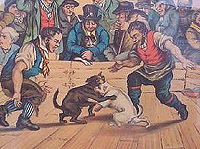Breed History

Reflecting on Pit Bulls – Whatever they are!
For the purpose of this website, we’ve chosen to use the generic term ‘pit bull’ to describe our dogs, even though there is no proper definition for pit bull. Recent research utilizing canine DNA has demonstrated that dogs who are commonly identified as pit bulls based on their appearance are quite often a mix of multiple breeds, so we now know that relying on visual identification alone for breed identification is inaccurate and even misleading.
What a dilemma! The conundrum is a good one though, because it frees us up to look at these incredibly popular dogs as a fascinating American phenomena rather than an identifiable item with fixed genetics, behaviors and definable features. Welcome to our exploration of the enigmatic pit bull!
Above: Two different centuries, two celebrated ‘pit bulls.’ On the left, Sergeant Stubby is celebrated for saving human lives in WWI. In 2010, Jonny Justice is celebrated for surviving the cruelties of NFL Player Michael Vick and going on to help children learn to read.
The ‘pit bulls’ you meet may be shelter dogs of indeterminate origin or they may have pedigree as American Staffordshire Terriers, Staffordshire Bull Terriers, American Pit Bull Terriers (APBT) or more recently, American Bullies. Whichever definition or registry you prefer, fanciers and animal lovers alike can agree that the dogs that fall under this label are as well-loved as they are maligned in this society, with a history that’s as blended as their genetics. While we puzzle over what a pit bull is, we should all take note that this blocky headed group of watzit dogs has been dutifully helping us learn what it means to be human. With unfailing optimism, the dogs that fill our shelters and homes seem to want to remind us that they are what we’ve made them to be, either victims of human cruelty, neglected sentries in lonely yards, or cherished family companions in our homes. The really good news is that society is starting to recognize these lessons and accept responsibility for their station in life.
 Created in the UK
Created in the UK

 History in America
History in America
Immigrants brought their dogs across the ocean along with their families and prized possessions. They soon became a fixture in a developing nation. In early America, the dogs were valued for much more than their fighting abilities. They were entrusted to protect homesteads from predators and worked as vital helpers on family farms. Homesteaders relied on their abilities to help in hunts and as hog catchers (hence, the common title “catch dogs”). They were constant companions to the young children who are seen in untold numbers of vintage photos with their family dogs. Pit bulls earned their place as an important part of the fabric of a developing nation.
Like the vintage photos? See our Vintage Photo Gallery here.
As cities sprung up, Pit Bulls remained a prominent part of the American culture. The USA admired this breed for qualities that it likened in itself; friendly, brave, hardworking, worthy of respect. Pit Bulls were thought of less as pit fighters and more as ‘regular dogs’. They show up in hundreds of turn of the century photos, flanked by loving family members. Early advertisements, posters, and magazines began to use the image of the All American Dog, including Buster Brown, whose companion was a Pit Bull.

The pit bull was also a favorite dog among politicians, scholars, and celebrities. Helen Keller, Theodore Roosevelt, and the “Our Gang” Little Rascals all had pit bulls. Many reading this website may have grandparents and great grandparents who kept a favorite pit bull as a pet. Today, this tradition continues with countless numbers of Americans who love and cherish their family pit bulls.
Character over Form

Pit bulls are beautiful in their variety, but their most appealing features are their inner qualities. Strength, confidence, a sense of humor and a zest for life are all hallmarks of the breed. They also tend to be sensitive and get their feelings hurt easily. Properly socialized dogs are quite affectionate and friendly, even with strangers, and therefore do not make good guard dogs. They’re intelligent and eager to please and tend to remain playful throughout their lives. While some can be low key ‘couch potatoes,’ many others need a job to channel their enthusiasm and energy. They excel in dog sports, search and rescue work, drug and bomb detection work, and as therapy dogs. Severe shyness, fearfulness or human-directed aggression is not characteristic of the breed and highly undesirable in any dog.
What’s in a Name?
AmStaff or APBT? AKC? UKC? ADBA or ABKC? So many registries, so many ways to label a “pit bull!”
“American Staffordshire Terrier” is not a polite new name for pit bull, although it’s often misapplied by people who dislike the term ‘pit bull.’ Understanding the jumbled history of the breed names helps to clear up some of this confusion and mislabeling.

The American Staffordshire Terriers have been developed since that time for conformation, while the APBTs have been developed for working drive, in addition to conformation. The two styles are basically mirror images of each other, with slight differences in build and character that have started to show over the past 65 years. To make matters even more confusing, some AmStaffs are dual registered as both UKC APBTs and AKC AmStaffs, while APBTs cannot be registered with both organizations. Depending on who you talk to, AmStaffs and APBTs can be the exact same breed, or completely separate breeds.
In 1909, Guy McCord founded an organization titled ADBA (American Dog Breeders Association). This was created exclusively for APBTs and continues to be the lead registry for this breed. In 1976, the ADBA outlined its own breed standard, or, Basis of Conformation. In 1990, a new registry called ABKC was formed to promote ‘American Bully’ dogs – a new breeding style of thick, bulldoggy looking dogs that are said to have English Bulldog in their background as well as other breeds.
 A Lonely Twist In the Road
A Lonely Twist In the Road

Dogfighting is now a felony in all 50 states and arrests have increased, and many now work to restore the dogs’ image to its rightful place as an American tradition. But even the most responsible owners still struggle to keep their dogs safe from discrimination and harm. The larger threats to the dogs are much more insidious and mainstream than even the threat of dog fighting, and result in an unforgivable prejudice that condemns countless pit bulls to homelessness and an early death. It is the housing market that routinely forces families to surrender their dogs to crowded shelters because no property owner will rent to them – even to a hero dog. It’s ill-informed professionals, like a librarian in an affluent San Francisco suburb, who promotes profiling dogs based on appearance.
It’s become public policy when law-makers misuse their positions to remove and destroy innocent pets from their responsible families in places like Denver, rather than adopt progressive policies that work to create safe, humane communities. Once again, pit bulls reflect back to us who we are: A culture of incredible contrast and conflicting beliefs about our roles and responsibilities as stewards of our canine companions.
Still Heroes
Despite the societal pressures many of the dogs and their owners endure, one thing rings true: The canine hero who was admired by this country’s earliest citizens continues to show itself in the faces of the overwhelming majority of pit bulls in our homes and even most of our shelters. The animal that was once courageous enough to grab a bull by the nose or save human lives on a WWI battlefield, now utilizes that same bravado to accomplish modern day feats — including surviving conditions that would drive most humans to madness.

Link to Sports Illustrated Article. Breed enthusiasts celebrated this historic issue and hailed it as a sign of a welcome change in the landscape.
In loving and committed homes they dazzle us with unmistakable charms. It’s not hard to see that the original Hero Dog is still alive and well in the show ring, in the various dog sport competitions, in law enforcement work, in our homes, and even in the saddest of places in our urban shelters.
We’d like to think that BAD RAP’s rescued pit bulls accurately reflect that same original spirit of tail wagging resiliency. We hope to inspire others to take a second look at the breed that has so much to say to us about its strengths and qualities as well as who we are as a nation of doglovers. Thank you for stopping by!


 Created in the UK
Created in the UK
 History in America
History in America

 A Lonely Twist In the Road
A Lonely Twist In the Road
